Palacios De Bellas Arte East Los Angeles College 1988
| Palace of Fine Arts | |
|---|---|
| Palacio de Bellas Artes | |
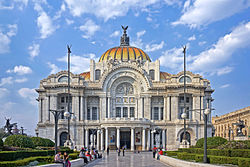 Front view of the Palacio de Bellas Artes | |
 | |
| General information | |
| Architectural fashion | Fine art Nouveau / Neoclassical (outside) Art Deco (interior) |
| Location | United mexican states City, Mexico |
| Coordinates | nineteen°26′8.3″N 99°eight′28.6″Westward / xix.435639°N 99.141278°W / 19.435639; -99.141278 Coordinates: nineteen°26′8.iii″Northward 99°8′28.6″W / 19.435639°Northward 99.141278°W / nineteen.435639; -99.141278 |
| Construction started | i Oct 1904 |
| Inaugurated | 1934 |
| Blueprint and structure | |
| Architect | Adamo Boari, Federico Mariscal, Géza Maróti, Agustí Querol Subirats, Edgar Brandt among others[i] |
| Other information | |
| Seating capacity | ane,936 |
The Palacio de Bellas Artes (Palace of Fine Arts) is a prominent cultural center in United mexican states City. Information technology has hosted notable events in music, trip the light fantastic, theatre, opera and literature in Mexico and has held important exhibitions of painting, sculpture and photography. Consequently, the Palacio de Bellas Artes has been called the "Cathedral of Fine art in United mexican states". The building is located on the western side of the historic eye of Mexico City next to the Alameda Cardinal park.
The first National Theater of United mexican states was built in the belatedly 19th century, but it was soon decided to tear this down in favor of a more opulent building in fourth dimension for Centennial of the Mexican State of war of Independence in 1910. The initial design and construction was undertaken by Italian architect Adamo Boari in 1904, but complications arising from the soft subsoil and the political problem both before and during the Mexican Revolution, hindered so stopped construction completely by 1913. Structure began again in 1932 under Mexican builder Federico Mariscal and was completed in 1934. It was then inaugurated on Nov 29 1934 and was the starting time art museum in Mexico dedicated to exhibiting creative objects for contemplation.
The exterior of the building is primarily Art Nouveau and Neoclassical and the interior is primarily Art Deco. The edifice is all-time known for its murals past Diego Rivera, Siqueiros and others, as well every bit the many exhibitions and theatrical performances it hosts, including the Ballet Folklórico de México.[two]
History [edit]


The oldest known structure on the site was the Convent of Santon Isabella, whose church was built in 1680. Still, significant Maya finds, such as a sacrificial altar in the shape of a plumed snake have been found here. The convent surface area suffered frequent drought during the early on canal period and development here grew quickly.
In spite of this, the convent remained until it was forcibly closed in the 1860s by the Reform Laws. It was replaced by a fabric factory and lower-class housing.[2]
A section of this housing, on Santa Isabel Alley, was torn down and replaced by the National Theater in the latter 19th century. During the late 19th century and very early on 20th, this theatre was the site of nigh of Mexico City'southward high civilization, presenting events such as theatre, operettas, Viennese dance and more.
It was so decided to replace this building with a more than opulent 1 for the upcoming Centennial of Mexican Independence celebrations in 1910. The old theatre was demolished in 1901, and the new theatre would be called the Gran Teatro de Ópera. The work was awarded to Italian architect Adamo Boari, who favored neoclassical and art nouveau styles and who is responsible for the Palacio del Correo which is across the street.[2] [3] Adamo Boari promised in October 1904 to build a grand metallic structure, which at that time just existed in the The states, only not to this size. The first stone of the edifice was placed past Porfirio Díaz in 1904.[4] Despite the 1910 deadline, by 1913, the building was hardly begun with only a basic shell. One reason for this is that the project became more complicated than anticipated equally the heavy building sank into the soft spongy subsoil. The other reason was the political and economic instability that would lead to the Mexican Revolution. Total hostilities suspended construction of the palace completely and Adamo Boari returned to Italy.[2] [3]
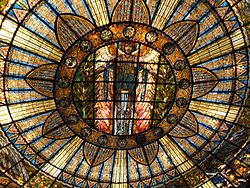
The projection would sit down unfinished for about 20 years. In 1932, structure resumed nether Mexican architect Federico Mariscal. Mariscal completed the interior but updated it from Boari's plans to the more modern Art Deco style. The building was completely finished in 1934,[two] [3] and was inaugurated on 29 November of that year.[4] The inaugural work presented in the theatre was "La Verdad Sospechosa" by Juan Ruiz de Alarcón in 1934.[5] In 1946, the Instituto Nacional de Bellas Artes (National Found of the Fine Arts) was created as a government bureau to promote the arts and was initially housed at the Museo Nacional de Artes Plásticas, the Museo del Libro and other places. It is now at the Palacio.[2]
In this theatre, Maria Callas debuted in the opera Norma in 1950.[v]
In 2002, the Palace was the scene of the funeral of María Félix.[5]
Since its initial construction, very little has been updated or modified. However, intensive renovation efforts were begun in 2009 for the upcoming 2010 celebrations.[four] Much of the equipment and machinery is original from the early on 20th century. Much of the technological equipment is being updated, especially in the theatre which needs computerized lights, sound systems and other improvements. Other work will improve the acoustics.[6] Upgrades to the theatre will allow for multimedia shows which were not available before.[7] The primary hall has had no renovation or upgrade work since it opened in 1934.[half-dozen] Renovations hither volition lessen the number of people the hall can accommodate but should make the area more comfortable.[7]
The building [edit]

Art Deco depiction of Chaac on a light console
The palace has a mixture of a number of architectural styles; however, it is principally Art Nouveau and Fine art Deco.[2] Art Nouveau dominates the outside, which was done by Adamo Boari, and the inside is dominated by Fine art Deco, which was completed past Federico Mariscal. Since construction began in 1904, the theater (which opened in 1934) has sunk some 4 meters into the soft soil of Mexico Metropolis.[8] The chief facade, which faces Avenida Juárez, is made of white Italian Carrara marble. In the interior of the portal are sculptures by Italian Leonardo Bistolfi. Information technology consists of "Harmony", surrounded by "Pain", "Rage", "Happiness", "Peace" and "Love". Some other portion of the facade contains cherubs and sculptures representing music and inspiration.[two] On the plaza forepart of the building, designed past Boari, at that place are four Pegasus sculptures which were made by Catalan Agustí Querol Subirats. These had been in the Zocalo earlier existence brought here.[ii] The roof covering the center of the building is made of crystal designed by Hungarian Géza Maróti and depicts the muses with Apollo.[4] One attribute of the Palace which has since disappeared is the "Pergola", which was located in the Alameda. It was constructed to firm pictorial exhibitions for the 1910 celebrations, merely it was demolished in 1973.[2]

The interior is too surfaced in Carrara marble.[4] It divides into three sections: the main hall with adjoining smaller exhibition halls, the theatre and the offices of the Insituto Nacional de Bellas Artes. The main hall is covered by the Marotti glass and fe roof. Information technology and the balconies of all three upper floors tin can be seen from the footing floor beneath.[two] In areas of the chief hall, pre-Hispanic motifs washed in Art Deco fashion, such as serpents' heads on window arches and Maya Chaac masks on the vertical low-cal panels distinguish this interior from its contemporaries.[three] The smaller exhibition halls are located on the first and second floors. The first floor is busy with crystal lamps, created past Edgar Brandt and concord murals past Rufino Tamayo. The Adamo Boari and Manuel M. Ponce halls hold music and literature events. And the National and International halls are for exhibitions. The second floor has smaller exhibition halls every bit well every bit murals by José Clemente Orozco, David Alfaro Siqueiros, Diego Rivera, Jorge González Camarena, Roberto Montenegro and Manuel Rodríguez Lozano. The tertiary floor is occupied by the Museum of Architecture. The ironwork was designed in Italia past Alessandro Mazzucotelli and in Mexico past Luis Romero Soto.[two]
At the entrance of the theatre, at that place are mascarons in statuary with depictions of Tlaloc, and Chaac, the Aztec and Maya deities of h2o, which along with the rest were designed by Gianette Fiorenzo. On the arch over the phase at that place are representations of various mythological personas such as the Muses with Apollo. This was constructed in Hungary in the workshops of Géza Maróti.[2] However, the most impacting aspect is the phase "curtain" which is a stained glass foldable panel created out of most a million pieces of irised colored drinking glass past Tiffany'due south in New York.[8] This phase curtain is the only one of its blazon in any opera house in the globe and weighs 24 tons.[4] The design of the curtain has the volcanos Popocatépetl and Iztaccíhuatl in the center. Around them is a Mexican landscape surrounded by images of sculptures from Yautepec and Oaxaca. This pattern was inspired by work done by artist Gerardo Murillo (Dr. Atl).[2] [viii] The theatre has a capacity of 1,000.[9]
Events [edit]

Liberación (Liberation) or La humanidad se libera de la miseria (Humanity is released from Misery), 1963, Jorge González Camarena
The Palace has been the scene of some of the most notable events in music, dance, theatre, opera and literature and has hosted of import exhibitions of painting, sculpture and photography.[ citation needed ] It has hosted some of the biggest names from both Mexico and abroad. It has hosted poetry events as well as those related to pop culture.[x] Artists and companies are from all parts of Mexico and abroad.[11] It has been called the "Cathedral of Art in United mexican states"[10] and is considered to be the most important theatre and the nearly important cultural center in Mexico. It was declared an artistic monument in 1987 by UNESCO. The building is administered by the Instituto Nacional de Bellas Artes of the federal authorities.[4] The palace receive on average 10,000 visitors each week.[9]
Ii of the best-known groups which regularly perform here are the Ballet Folklórico de México Compania Nacional de Opera de Bellas Artes and the National Symphonic Orchestra.[12] The commencement performs in the theatre twice a week and is a spectacle of pre and postal service Hispanic trip the light fantastic toe of Mexico. A typical program includes Aztec ritual dances, agricultural dances from Jalisco, a fiesta in Veracruz, a wedding celebration — all accompanies by mariachis, marimba players and singers.[3] [4] Regular annual events include the Premio Quorum for Mexican designers in graphic and industrial materials[xiii] and the Premios Ariel for Mexican films.[fourteen]

La nueva democracia (The New Republic), 1945, Siqueiros
Numerous private events have been held here. These include several exhibitions of Frida Kahlo'southward work,[15] [16] and a number of appearances past Luciano Pavarotti.[17] In 1987, Bellas Artes hosted a legendary operation of Jesusa Rodríguez's Donna Giovanni, an accommodation of Mozart'southward opera with a female bandage.[18] Other appearances have been made past Mexican baritone Jorge Lagunes (2002)[19] and Catalan guitarist Joan Manuel Serrat (2003).[20] Events that have been held here include "ABCDF Palabras de Ciudad" (2002) showing life in popular housing in photographs and video, "Bordados del Mexico Antiguo" (Embroidery of Old Mexico) showing processes, history and design,[13] Rem Koolhaas Premio Pritzker 2000" briefing[21] and "Exchanging Views: Visions of Latin America" which was an exhibit from the collection of Patricia Phelps de Cisneros comprising 148 works past 72 artists from across Latin America in 2006.[22]
Occasionally, the plaza in front of the Palace is the scene of protests such as those against the Iraq State of war in 2003[23] and against bullfighting in 2010.[24]
Murals [edit]
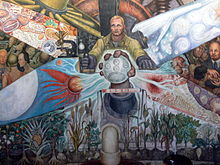
The floors between the ground flooring and the uppermost floor are dominated past a number of murals painted by most of the famous names of Mexican muralism.[8]
On the 2nd flooring are ii early-1950s works past Rufino Tamayo: México de Hoy (Mexico Today) and Nacimiento de la Nacionalidad (Nascency of Nationality), a symbolic depiction of the creation of the mestizo (person of mixed indigenous and Spanish ancestry) identity.[iii]
At the west end of the 3rd floor is El hombre controlador del universo (Man, controller of the universe- known every bit Human at the Crossroads), originally deputed for New York's Rockefeller Center in 1933. The mural depicts a diverseness of technological and societal themes (such every bit the discoveries made possible by microscopes and telescopes) and was controversial for its inclusion of Lenin and a Soviet May Day parade. The Rockefellers were not happy with the painting and the incomplete work was somewhen destroyed and painted over. Rivera recreated it here in 1934.[3] [8] On the northward side of the third floor are David Alfaro Siqueiros' three-office La Nueva Democracía (New Democracy) and Rivera's four-part Carnaval de la Vida Mexicana (Funfair of Mexican Life); to the eastward is José Clemente Orozco's La Katharsis (Catharsis), depicting the conflict between humankind's 'social' and 'natural' aspects.[3]
Museo del Palacio de Bellas Artes [edit]

View of the interior art deco
The Museo del Palacio de Bellas Artes (Museum of the Palacio de Bellas Artes) is the organization that takes care of the permanent murals and other artwork in the building besides as arrange temporary exhibits. These exhibits cover a wide range of media and characteristic Mexican and international artists, focusing on classic and contemporary artists.[25]
Museo Nacional de Arquitectura [edit]
The Museo Nacional de Arquitectura (Museum of Architecture) occupies the top floor of the building, covered by the glass and fe roof. It contains exhibitions from renowned Mexican architects including models, designs and photographs of major works. The museum also arranges temporary exhibitions of its collections in other facilities to expose the Mexican public to the country's rich architectural heritage. Some of the major architects featured at the museum include Jaime Ortiz Monasterio, Carlos Mijares Bracho, Adamo Boari and Luis Barragán.[26] The museum is divided into four sections called "Arquitectura-contrastes: Jaime Ortiz Monasterio y Carlos Mijares Bracho", "Corpus Urbanístico de la Ciudad de México", "Teatro Nacional de México (Plano original)" and "Teatro Nacional de México."[27] There are also temporary exhibits on contemporary architecture.[3]
Gallery [edit]
- Exterior views of the Palacio de Bellas Artes
-

Dusk in the Palacio de Bellas Artes, aerial view
-
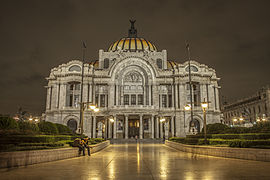
Night view of the Palacio de Bellas Artes
-
Night view with warm lighting
-
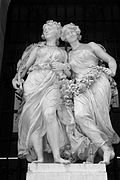
-
Art Nouveau hawkeye sculpture

- Historical images of the Palacio de Bellas Artes
-

Palacio de Bellas Artes in 1915, under structure[28]
Come across too [edit]
- Lincoln Center
References [edit]
- ^ "Palacio de Bellas Artes". The Fine art Nouveau Globe.
- ^ a b c d e f chiliad h i j k l m due north "Palacio de Bellas Artes" (in Castilian). United mexican states City: Secretary of Tourism of Mexico. 2005-02-07. Archived from the original on 2010-04-08. Retrieved 2010-02-18 .
- ^ a b c d e f g h i "Palacio de Bellas Artes". Alone Planet Guides. Archived from the original on March thirteen, 2014. Retrieved February 18, 2010.
- ^ a b c d e f g h "Cumple 75 años el Palacio de Bellas Artes" [Palacio de Bella Artes' 75th birthday]. Noticias Televisa (in Spanish). United mexican states City. Notimex. September 30, 2008. Archived from the original on October 24, 2017. Retrieved 2010-02-18 .
- ^ a b c "Trivia / Historia: El Palacio de Bellas Artes" [Triva/History:The Palace of Bellas Artes]. El Norte (in Spanish). Monterrey, Mexico. 2006-09-27. p. 2.
- ^ a b "Avanza remodelación del Palacio de Bellas Artes" [Remodeling of the Palacio de Bellas Artes advances]. Noticias Televisa (in Spanish). Mexico Urban center. 2009-11-18. Retrieved 2010-02-18 .
- ^ a b Sánchez, Luis Carlos (2009-08-17). "Cirugía mayor al Palacio de Bellas Artes" [Major surgery for the Palacio de Bellas Artes]. Excelsior (in Spanish). United mexican states City. Archived from the original on 2017-ten-24. Retrieved 2010-02-18 .
- ^ a b c d eastward "Museo del Palacio de Bellas Artes". Frommers Guides. Retrieved February 18, 2010.
- ^ a b Garcia, Omar (2003-12-19). "Dan una 'manita' a Bellas Artes" [Giving a small manus to Bellas Artes]. Reforma (in Spanish). Mexico City.
- ^ a b Flim-flam, Vicente (2005-09-29). "El Palacio de Bellas Artes ha sido y seguirá siendo la Catedral del Arte en México" (in Spanish). Role of the President (Mexico). Archived from the original on 2016-03-08. Retrieved 2010-02-xviii .
- ^ "Palacio de Bellas Artes". Frommers Guides. Retrieved February 18, 2010.
- ^ Haw, Dora Luz (2003-08-19). "Escenifican 'Carmen' ante un mayor publico" [Staging Carmen in front of a major audience]. Reforma (in Castilian). Mexico City. p. 4.
- ^ a b Rivas, Affections (2002-05-06). "Enterese" [Become involved]. Reforma (in Spanish). Mexico City. p. 4.
- ^ "Tienen fiesta de pelicula" [Films have a party]. El Norte (in Spanish). Monterrey, Mexico. 2004-04-01. p. 1.
- ^ "Inauguran exposicion de Frida Kahlo en Bellas Artes;" [Frida Kahlo exposition inaugurates at Bellas Artes]. Noticias Financieras (in Spanish). Miami. 2004-08-05. p. 1.
- ^ Malkin, Elisabeth (2007-07-07). "Across the Myth, Art Endures". New York Times. New York. Retrieved 2010-02-18 .
- ^ Sanchez, Leticia (1996-12-23). "Pavarotti y mucha opera sonara en Bellas Artes" [Pavarotti and much opera will audio off in Bellas Artes]. Reforma (in Spanish). Mexico Metropolis. p. four.
- ^ Gutiérrez, Laura Thou. (2010). Performing Mexicanidad: Vendidas Y Cabareteras on the Transnational Stage. University of Texas Printing. p. 77. ISBN9780292779198.
- ^ Cruz, Antimio (2002-10-07). "Se siente Lagunes solido en su trabajo" [Lagunes feels solid about his work]. Reforma (in Spanish). United mexican states City. p. two.
- ^ Lopez, Sergio Raul (2003-05-09). "Intima Serrat en Bellas Artes" [Serrat give intimate operation at Bellas Artes]. Reforma (in Spanish). United mexican states City. p. 22.
- ^ Buzio, Erika P. (2007-03-03). "Dice Koolhaas alto al mercado". Reforma (in Spanish). Mexico City. p. 8.
- ^ "Avant-garde Latin American Art Fatigued from Coleccion Patricia Phelps de Cisneros on View at Museo del Palacio de Bellas Artes". Business organisation Wire. New York. 2006-07-26. p. 1.
- ^ Alvarez, Carmen (2003-03-xi). "Construyen con arte un cerco a la guerra" [Constructing with fine art a fence confronting war]. Reforma (in Spanish). Mexico City. p. 4.
- ^ "Protestan frente al Palacio de Bellas Artes contra la tauromaquia" [Protests in front of the Palacio de Bellas Artes against bullfighting]. Excelsior (in Spanish). United mexican states City. 2010-02-06. Archived from the original on 2010-03-17. Retrieved 2010-02-eighteen .
- ^ "Presentación" [Presentation]. United mexican states: Instituto Nacional de Bellas Artes. Archived from the original on 16 January 2010. Retrieved 18 Feb 2016.
- ^ "Presentación" [Presentation]. Mexico: Instituto Nacional de Bellas Artes. Archived from the original on February i, 2009. Retrieved Feb 18, 2010.
- ^ "Obras representivas" [Representative Works] (in Spanish). Mexico: Instituto Nacional de Bellas Artes. Archived from the original on October 6, 2009. Retrieved Feb 18, 2010.
- ^ Massimo Barzizza. "Boari l'architetto della cultura". puntodincontro.mx (in Italian).
External links [edit]
- Palacio de Bellas Artes website Archived 2019-04-27 at the Wayback Machine at palacio.bellasartes.gob.mx/
- "Palacio de Bellas Artes - Insight". sobrearquitectura.com.
Source: https://en.wikipedia.org/wiki/Palacio_de_Bellas_Artes


0 Response to "Palacios De Bellas Arte East Los Angeles College 1988"
Post a Comment